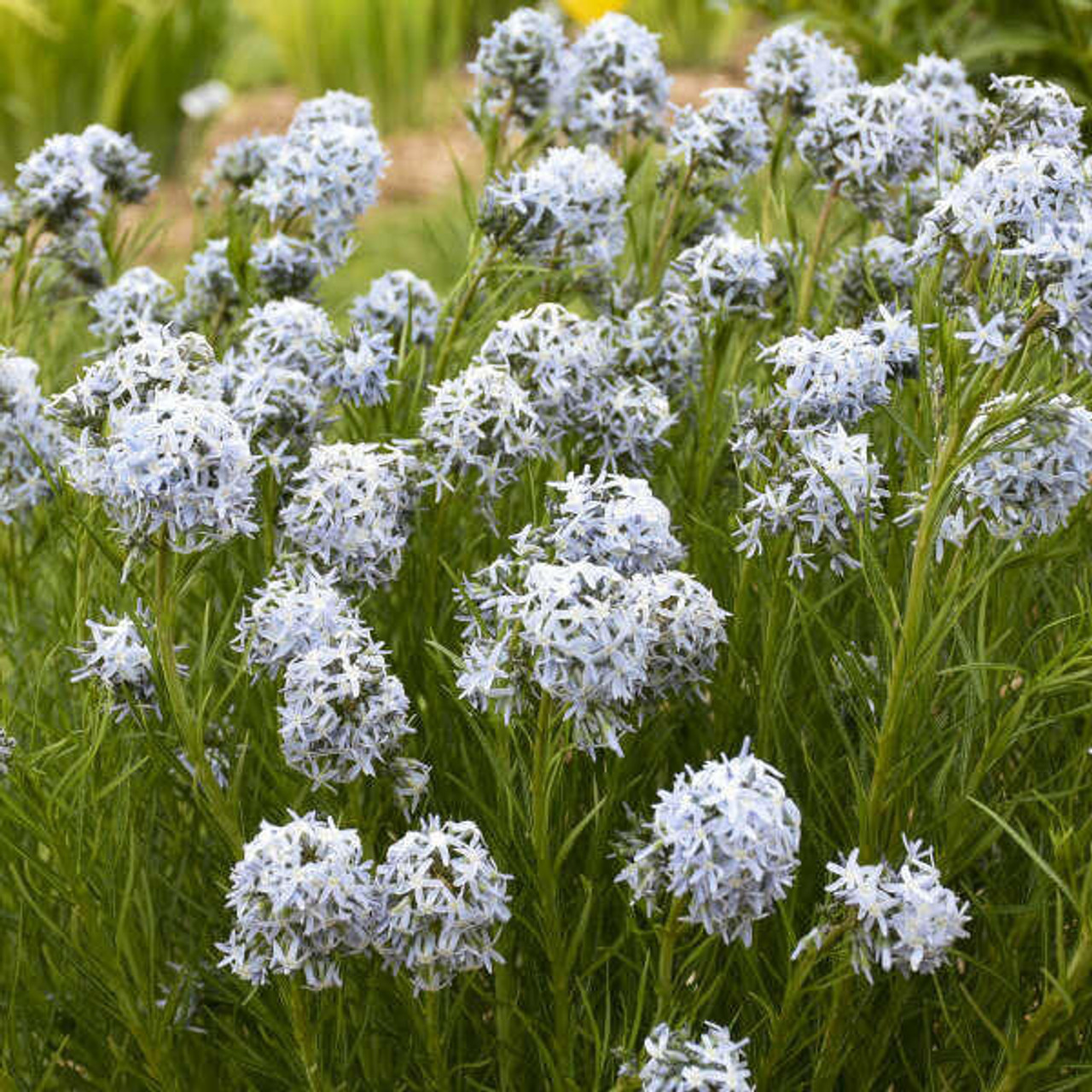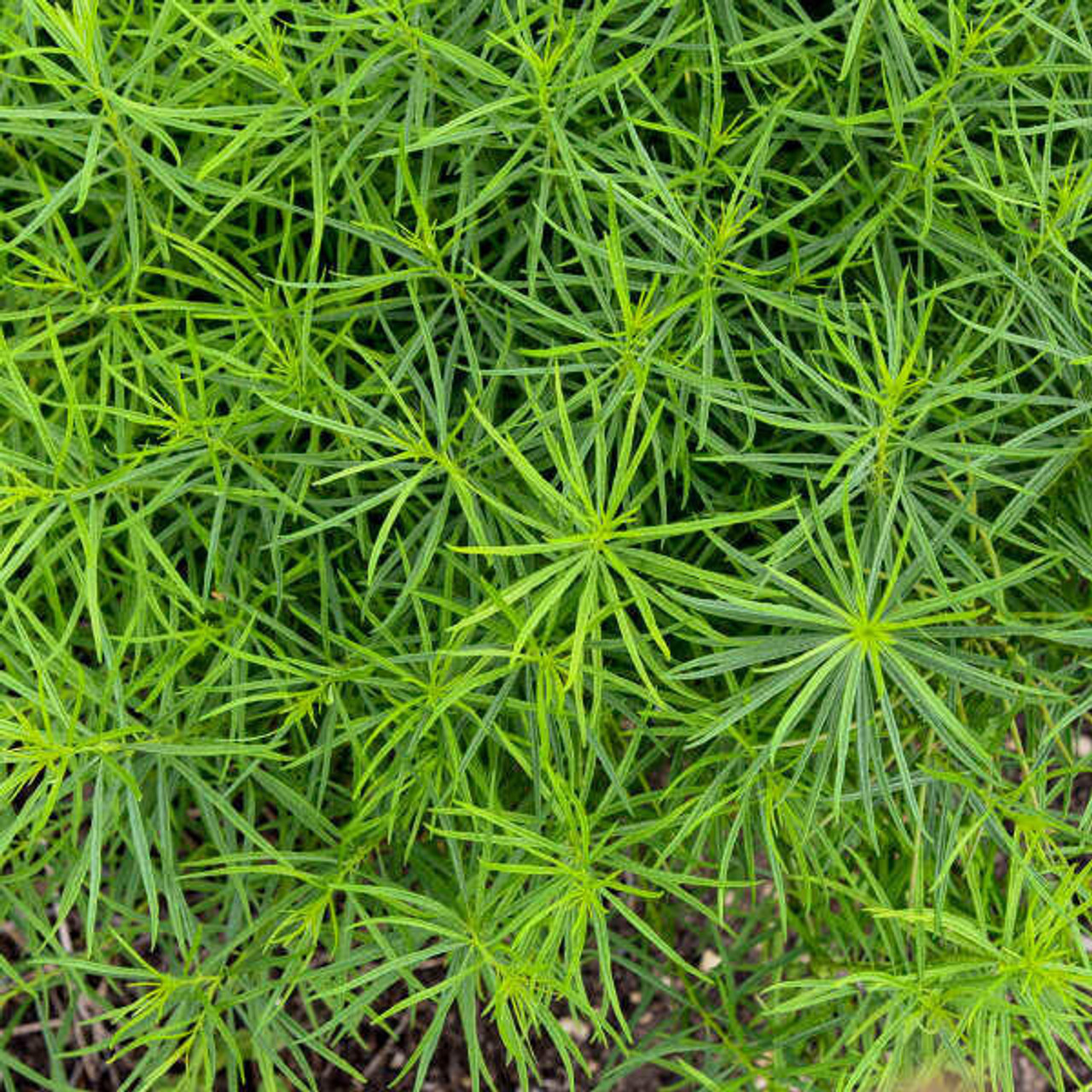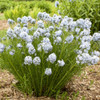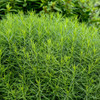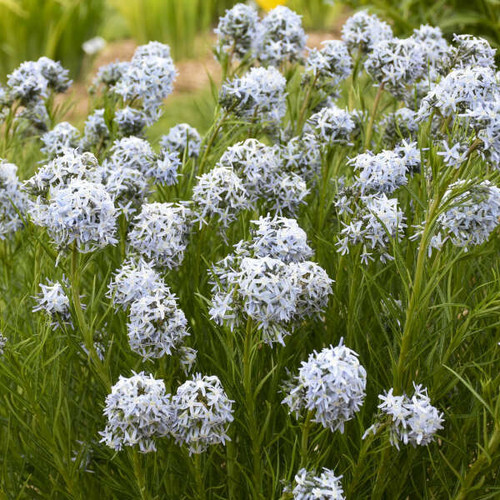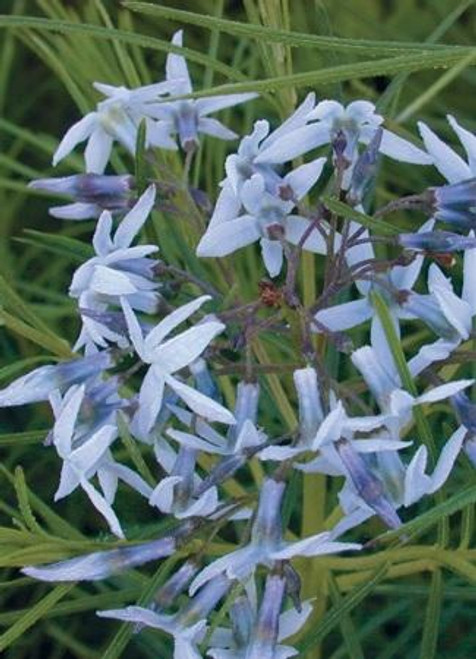Product Description
Amsonia 'String Theory' PP34419 CPBRAF (4) 1-gallons
Common Name: Blue Star
People have loved 'Storm Cloud' and we are now pleased to offer a complementing threadleaf Amsonia to the Proven Winners program. 'String Theory' can be described as a compact version of the industry standard Amsonia hubrichtii. The compact habit is covered with light periwinkle blue flowers in late spring, flowering later than 'Storm Cloud'. While other Amsonia can often display chlorotic leaves, 'String Theory' displays healthy dark green leaves throughout the summer. We have observed the same brilliant golden orange fall color as you would expect from A. hubrichtii.
This easy care, heat and humidity tolerant, deer resistant perennial is an excellent choice for gardeners looking for low maintenance or native perennials.
Amsonia thrives in most gardens with little care. It is low-maintenance, easy to grow and trouble-free. Plant it in full sun or partial shade and moist soil of average fertility. If grown in too much shade or very rich soil, its habit will be open and floppy. This plant grows fairly large but it will not need to be divided for many years. Cutting the stems back to within 6-8" of the ground after flowering will result in fuller growth.
Height: 18.0-22.0 Inches
Spread: 32.0-36.0 Inches
Hardiness Zones: 4,5,6,7,8,9
Flower Color: Blue shades
Foliage Color: Green shades
Full Sun to Part Shade
Average to Consistent Water Needs
Poor to Fertile Soil Quality
Bloomtime: Late Spring to Early Summer
Deer Resistant
Seasonal Interest: Fall Color
Growth Rate: Medium
Border Plant, Cut Flower, Cut Foliage, Easy To Grow, Attractive Foliage, Mass Planting
Amsonia 'String Theory' is a fantastic choice for a low-maintenance, beautiful perennial that adds texture and color to your garden throughout the seasons. Here is why it is becoming so popular:
Unique Features:
- Fine, Thread-like Foliage: 'String Theory' stands out with its exceptionally fine, almost thread-like leaves. This gives it a delicate and airy texture, unlike many other plants. The foliage is a vibrant green throughout the summer, providing a lovely backdrop for its blooms and later, its fall color.
- Soft Blue Flowers: In late spring to early summer, 'String Theory' is adorned with clusters of delicate, light periwinkle blue flowers. These blooms rise above the foliage, creating a beautiful contrast and attracting pollinators.
- Stunning Fall Color: As autumn approaches, the foliage of 'String Theory' transforms into a brilliant golden orange, providing a spectacular display that extends the plant's interest well into the fall.
- Compact and Well-Behaved: Compared to some other Amsonia varieties, 'String Theory' is more compact and maintains a neat, mounding shape. It typically grows to about 18-22 inches tall and 32-36 inches wide.
Growing Conditions:
- Sun to Partial Shade: 'String Theory' thrives in full sun to partial shade. It flowers best with at least 6 hours of sunlight, but it can tolerate some shade, especially in hotter climates.
- Adaptable to Soil: It can tolerate a variety of soil types, including clay, sandy, and loamy soils, as long as they are well-drained.
- Drought-Tolerant: Once established, 'String Theory' is quite drought-tolerant, making it a great choice for dry gardens or areas with limited watering.
Care and Maintenance:
- Low Maintenance: 'String Theory' is a very low-maintenance plant. Once established, it requires minimal care.
- Watering: Water regularly during the first year to help it establish its roots. After that, it can tolerate dry periods.
- Fertilizing: Generally, it does not require regular fertilization, but a light feeding in spring can be beneficial.
- Pruning: No pruning is usually needed, but you can trim it back in late fall or early spring to maintain a tidy appearance.
Uses in the Garden:
- Borders and Edging: Its compact size and neat habit make it perfect for edging borders, pathways, or garden beds.
- Mass Plantings: Planted in mass, it creates a beautiful and textured ground cover.
- Mixed Borders: It adds a unique texture and color to mixed borders with other perennials and shrubs.
- Containers: It can also be grown in containers, adding a touch of elegance to patios or balconies.
Benefits:
- Attracts Pollinators: The flowers attract bees and butterflies, making it a valuable addition to pollinator gardens.
- Deer-Resistant: Deer tend to avoid Amsonia, so it is a good choice for gardens where deer are a problem.
- Low-Maintenance: Its drought tolerance and minimal care requirements make it an ideal plant for busy gardeners.
- Year-Round Interest: With its beautiful flowers, attractive foliage, and stunning fall color, 'String Theory' provides interest throughout the seasons.
If you are looking for a unique, low-maintenance, and beautiful perennial to add to your garden, Amsonia 'String Theory' is an excellent choice! Its fine foliage, soft blue flowers, and vibrant fall color make it a standout in any landscape.
(4) 1-gallon containers ready to plant, plants may be trimmed for shipping,
Other Details
The most important part of the plant is its root system. Healthy roots are the foundation of a healthy, vibrant plant. The type of plug container used is based on the specific needs of the plants. Perennials offered as bare root traditionally perform better when planted as bare root.Planted in a specialized mix, potted plants have well established root systems. Top growth stage will vary depending on the current life cycle and time of year when shipped. In Winter and early Spring dormant plants may be shipped. Dormant plants may be planted right away, even before the last frost date.
Most bare root varieties are field grown for at least one season, though Hemerocallis and Hosta are grown for two seasons. The bulk of the soil is removed during the harvesting process and the tops of most varieties are trimmed back to the crown. They are graded, packed in shredded aspen or sphagnum moss and stored in freezers until ready to be shipped.
See our Container Sizes and Bare Root Perennials pages for more information.
Plant information and care is provided in the Overview section, Plant Genus Page and general information is provided in the Planting Care & Guides. Additional questions can be asked on each Plant page.
Plant Spacing: Using the maximum mature spread or width of a plant to guide spacing, ensures space to grow to full size. To fill an area sooner, plant them closer together. Just remember, future thinning or transplanting may be needed.
Water: Keep a close eye on newly planted perennials, especially throughout the first growing year. Most early plant loss is due to too much or too little water!



